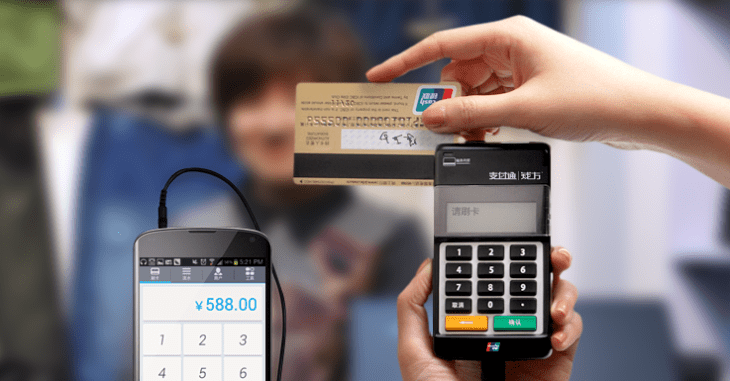QFPay‘s card reader admittedly looks a bit clunkier than its U.S. or European equivalents Square or iZettle.
It looks like a wonky, old calculator. But that’s because Chinese consumers don’t trust merchants easily and a basic phonejack reader without a keypad makes them nervous, says COO Tim Lee. He says consumers are worried that their PINs will get stolen by unscrupulous merchants.
“Aesthetically, it’s not that beautiful,” he said. “Square is very Apple-like and we’d want to have good design, but we are practical for two reasons. We must have a PIN pad in China and secondly, we have limited money so we’d want to build a minimum viable product and then keep on improving.”
Because of these more practical modifications, QFPay is seeing traction that has it processing close to $400 million per year on an annualized basis.
They have 30,000 merchants all over China and recently picked up funding from Sequoia China, although the size of the round is still undisclosed.
Among their clients are better-known names like Groupon-like 55Tuan, which uses QFPay to collect fees from merchants all across China.
QFPay’s model is slightly different from Square’s. For one, they don’t give away their readers for free. They charge 899 renminbi or just under $150 for each one. Competitors like Lakala also charge for their readers at about 199 renminbi a pop.
QFPay’s transaction fees also legally have to be a lot lower than what U.S. and European companies can charge. They don’t charge more than 0.78 percent per transaction, which is one-third of the 2.75 percent that Square charges. That cuts the company’s margins on every swipe, although Lee says that R&D costs are substantially lower in China.
QFPay also recently released an API that lets third-party developers create payment experiences. (Square does not currently offer an API.) It’s still early so there just 100 developers on the platform.
The Chinese market has myriad challenges, which could also be good opportunities for QFPay.
For one, penetration for point-of-sale terminals is still quite low. Lee says only about 5 million merchants out of China’s estimated 100 million have proper point-of-sale machines, so QFPay has to do a lot of education on why its products are valuable.
The country is also heterogeneous with different provinces having different business cultures.
“In the north, merchants just have a leisure life. They open the shop and go home at 5 of 6 p.m.,” he said. “But in the Southern provinces, they will stay open until midnight.” The Western provinces are also far less developed than the coasts, with many Chinese merchants still carrying feature phones.
Lee said they started working on the company about six months after Square launched. The company’s management team has experience working for PayPal, MasterCard, HSBC and Western Union; that breadth of experience spans the entire history of digital payments in the country.
They face internal competitors like Lakala and iBoxPay, but Lee says those are consumer-facing solutions. He says they basically target reader sales at consumers that want to pay for utilities and other services through their phones.
But QFPay is aimed at merchants and the company is working on all sorts of software tools to handle CRM, analytics and loyalty products.
